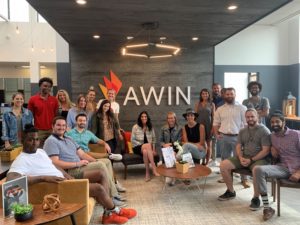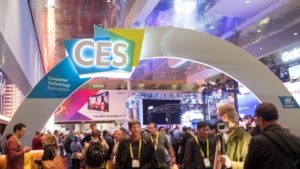
Ah, that all too familiar question. You’ve done your research, you’ve found a vendor, you’ve gone to get your employee influencer platform signed off and boom, you’ve been asked the daunting question:
What is the ROI for an Employee Influencer Program?
It’s a question we at DSMN8 get asked quite frequently, from both legacy clients and those simply wanting to dip their toes in employee influence. Well, fear not, we’ve got you covered.
It can at first seem challenging to measure the ROI from an employee influencer platform, and there’s a common misconception that it can take some time before you see any at all. This couldn’t be further from the truth, as in fact, most organizations will see ROI from an Employee Influencer program within as little of a month of implementation.
Before we show you how to measure ROI, let’s quickly revise how Employee Influence can be used as a performance marketing tactic.

AWIN launched an employee influencer program with DSMN8 back in 2018 (© AWIN)
Employee Influence as a Performance Marketing Tactic
An employee influencer program can be an invaluable resource for lowering your media spend.
LinkedIn, for example, requires companies to bid a minimum of $2 for cost-per-click campaigns. While the average CPC seen post-campaign is around $5.26.
On the other hand, companies leveraging the power of their employees to generate engagement with employee influencers are seeing a comparative cost-per-click that is, on average, less than $1. DSMN8 legacy client AWIN, for example, saw a comparative cost-per-click of $0.23. Check out the full AWIN case study.
With trust comes engagement, and so it’s no surprise that employee influencers generate high referral rates to a company’s website at a comparatively lower cost to traditional performance marketing.
“Employee shares on their personal social channels via DSMN8 has become one of the highest referrers of traffic to the AWIN site, securing employee advocacy as a core part of our marketing strategy. Seeing the results further motivates our teams to continue sharing company content.” – Sarah Ruzgar, Global Communications Lead (AWIN)
Okay, now that we’ve run through that, it’s time to get into the nitty-gritty process of measuring ROI (don’t worry, it’s really quite simple!)

Measuring ROI isn’t rocket science, we’ll keep it as simple as possible!
Measuring Employee Influence ROI
Let’s say, for example, that your company page on LinkedIn has 50,000 followers, 25,000 followers on Twitter, and 25,000 on Facebook. The combined Total Company Reach (TPR) is 100,000, which means that sharing a post across all three of those social channels could reach up to 100,000 people.
In comparison, the average LinkedIn user has 1,180 connections. If 100 employees were to share that same social post, the potential reach would be 118,000, surpassing your company reach with only 100 Employees!
Now, if you are a company with 10,000 employees sharing socially, the Total Employee Reach (TER) would be 11,800,000.
Working under a conservative estimate of only 15% of a 10,000 strong workforce signing up for your employee influencer program, the estimated reach would be 1,770,000—1,770% more than your 100,000 Total Company Reach.
What percentage of your workforce would need to be sharing for you to surpass your company page reach?
Companies leveraging the power of their employees as influencers tend to have 20-30% of their employees engaging with their employee influencer platform. According to DSMN8 data, the average user shares 2.2 pieces of company content per week and averages an impressive five clicks per share.
But let’s say, hypothetically, that only 15% of your employees (1500 employees) share eight pieces (2 per week) of company content per month (12,000 shares), and each generates a conservative average of 5 clicks per share.
That would total 60,000 clicks per month, which equates to 720,000 clicks per year.

Nope, the numbers don’t lie!
If you’ve dealt with social media advertising in the past, you’ll be familiar with cost per click. Imagine how much that amount of clicks would eat into precious budget! Let’s put it on paper (so to speak) to be as transparent as possible.
With LinkedIn ads, the average cost per click ranges between $4-7. To be as fair as possible, let’s say you began a campaign with LinkedIn offering $4 per click. The 60,000 clicks you could have generated in one month through your influencer platform would have cost your company $240,000 in comparative ad spend.
Now, using DSMN8’s data, the average cost per click from an Employee Influencer program would be somewhere between $0.50 to $0.90. This gives you a comparative cost per click that is 88% cheaper than the LinkedIn alternative.
And that’s just employee advocacy…
The effects of employee influence through advocacy is generally the big question that we get asked. However, as an employee influencer platform, we offer so much more than just employee advocacy. DSMN8 is the only all-in-one employee influencer platform that allows employees not only to share but to create and submit content, too.
Creating content at scale has long been a pain point for organizations big and small. After all, in the age of social media and short attention spans, it has never been more important to have a consistent and valuable presence online.

Leverage the power of your employees to create photo and video content at events (CES 2020)
In 2020, the average cost of a freelance writer for a blog post is just under £100 for 1000 words, according to Journo Resources.
The range of cost for freelance video and photography production varies drastically, but externally sourced video marketing ranges anywhere from $1000 – $50,000.
There’s no doubt that the quality would be there, but is it authentic? And does it showcase life at your company in a way that top candidates won’t see straight through?
Couple the price of your photo/video production with the cost of the 15 pieces of blog content you’d need each month (according to experts at Quoracreative), and you’re well on your way to eating into your marketing budget.
Of course, we may be slightly biased, but implementing an employee influencer program seems to be something of a no-brainer, right?
Ready to get started with the #1 employee advocacy platform?
Wondering how active your team already is, and how this compares with your competitors?
Lewis Gray
Senior Marketing Manager and Employee Advocacy Program Manager at DSMN8. Lewis specialises in content strategy, growing brand visibility and generating inbound leads. His background in Sales lends itself well to demand generation in the B2B niche.


